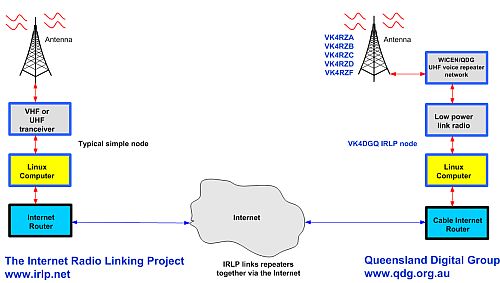Amateur Radio And The Internet
Where The Two Technologies Come Together
 |
The internet provides noise free broadband interconnection and radio provides mobility and the freedom of ready communication. Linking the two together has obvious advantages and has enabled many amateurs to enjoy aspects of radio communication previously denied to them by limitations such as ability to erect the appropriate antennas or limitations on transmitter power. The Internet linking of radio has also the advantage of point to point contact in that specific locations can be called up rather like dialling up your favourite village or town. Later developments are making it possible to dial up a specific radio station anywhere in the world when connected via the internet. The principal internet radio connections are through the modes of IRLP, Echolink and D-STAR. Particularly noteworthy is the creative part amateur radio operators have played in developing and introducing these systems confirming once again the experimental opportunities of the hobby.
IRLP
The diagram above shows the elements of an IRLP mode system. This one is that developed and installed by the Queensland Digital Repeater Group. IRLP is an acronym of Internet Radio Linking Project created by David Cameron VE7LTD (Canada). IRLP uses the Voice over Internet Protocol (VoIP) to provide a voice service between amateur radio stations via the internet. As can be seen in the above diagram IRLP entry from the amateur station is via a repeater, which acts as a communication node, and thence into the internet system to reappear at a remote amateur repeater and thence to any listening amateur stations. The system is usually accessed by VHF or UHF radios working to a repeater set up to handle IRLP traffic. The calling station, after checking the channel is free, enters the DTMF codes for the station being called and the IRLP system directs the call to that station. There are already more than 1400 nodes across 7 continents in the IRLP network and hence the amateur has no shortage of locations to call other amateurs around the world. Details of the downloadable software are found on the internet.
ECHOLINK
EchoLink was developed by Jonathon Taylor K1RFD (USA) to link personal computers to communicate by VoIP with the many thousand repeaters having the capability to operate with EchoLink. Whereas IRLP operates in a mode based on linking two amateur radio stations, EchoLink can also link amateurs through computers using microphone and soundcard as well as through radio links to repeaters connecting through the internet. There are well over 100 000 registered users worldwide. The software is downloadable from the internet.
D-STAR
D-STAR (Digital Smart Technologies for Amateur Radio) is a digital voice and data protocol specification developed for use in amateur radio and a significant advance on other methode of amateur communication This is truly Digital Radio making use of a wide range of the benefits and tools of digital technology including linking available via the internet ,. See the DIGITAL heading for more background information on this mode.
| 
